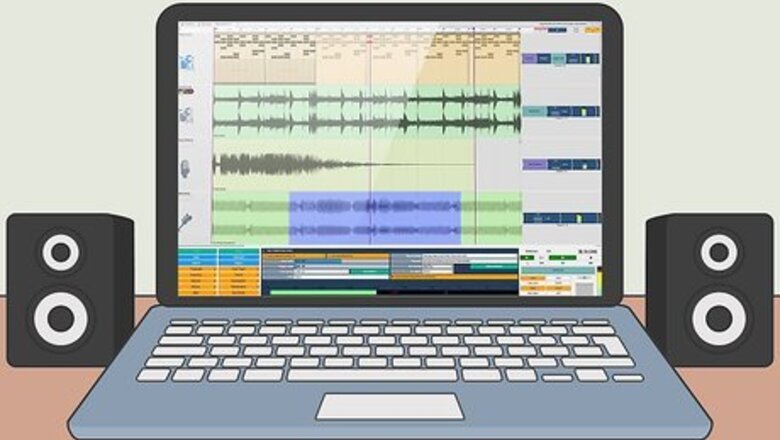
views
Queuing Songs
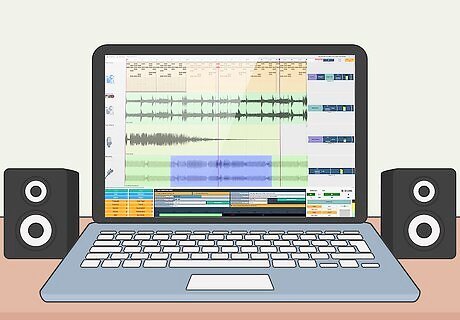
Open an audio mixing program. A good DJ program has a user-friendly interface and plenty of options for combining tracks. Many of these programs, such as Traktor and Serato, are bundled with control panels. Some programs like Virtual DJ and Mixxx are free options that have layouts similar to the paid products. Another option is djay Pro, which gives you the ability to practice making remixes by streaming songs from Spotify. Some production software programs also give you the ability to make tracks. Ableton Live is a little more complicated than mixing programs, but many popular artists use it live. All mixing programs are similar but have different user interfaces and features. Test different programs until you find one you like.

Choose music from the same genre for an easier time mixing. Songs that are similar to one another flow together better. Start off with 2 house music songs or 2 hip-hop songs, for instance. Pick songs that have a similar sound and beat to them. The more alike they sound, the easier they are to blend together. DJ mixing is all about transitioning between songs. Always try to find songs that give you an opportunity to create your own unique mix. Transitioning between songs of different genres is possible, but it often doesn’t produce a high-quality DJ mix. You don’t know until you try, so experimenting with your DJ program may help you uncover exceptions no one else thought of. It also helps to pick songs that are at a similar BPM and are played in a similar key.
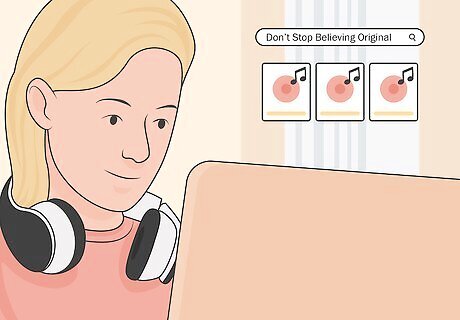
Pick unedited songs with clear audio quality for better mixing. Look for club or extended versions of songs. Radio versions are often heavily edited and not right for venues where DJs perform. Radio edits may be shortened, have altered lyrics, or use different sound levels. Getting quality songs ensures your mixes sound a lot more appealing. Listen to the whole song to determine its audio quality. Songs with a higher bit rate are usually better. You will be able to hear the difference between a 128 and 320 kbps song, and so will your audience.
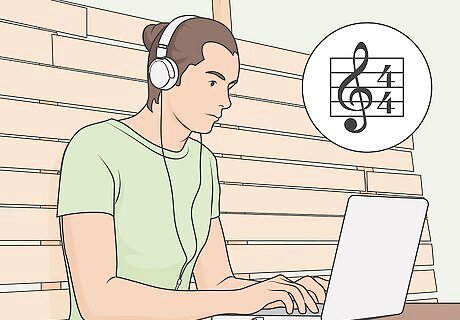
Listen to the songs to identify their time signature. A time signature is the number of beats per measure a song has. Most songs are written in 4/4 time, which means 4 quarter note beats per measure. For an easy time mixing songs together, stick to tracks that have identical time signatures. Great DJs know their tracks. Always listen to a track thoroughly before attempting to mix it. Find the time signature by counting the beats. Mixing songs with different time signatures is possible, but it requires a careful ear and some advanced techniques. When starting out, work with similar songs first to get accustomed to the tools available to you, then move on to harder material.

Queue up the songs side by side on your DJ program. No matter which software program you use, it will have space on the left and right side of the screen for the songs. These spaces correspond to the controls on your DJ equipment. Use the controls on the left side of the board to alter the left song and use the controls on the right to alter the right song. Make sure you know what all of the buttons do on your controller. You will need the volume controls and faders to mix songs effectively.
Transitioning Between Songs
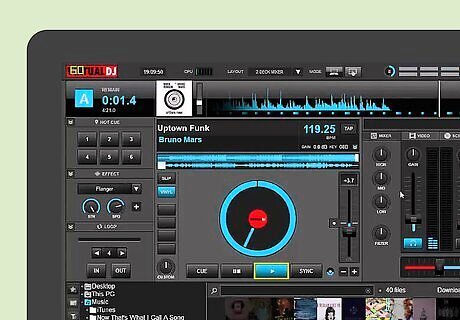
Start playing the first song on your playlist. Hit the play button on the controls to begin 1 of the songs. Check the volume levels and the faders. Make sure everything sounds perfect and that the next song is ready to take over when the first song ends. Watch your computer screen for an indication of what song is active. Many programs record soundwaves, allowing you to keep track of the beat. Follow the beat for an idea of when to begin transitioning songs.
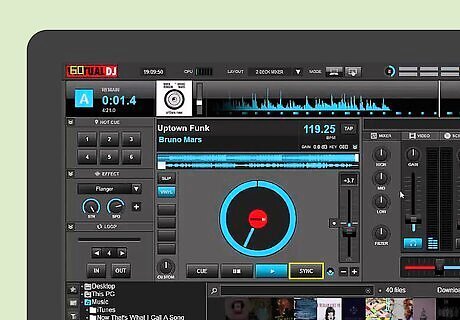
Sync the lower-pitched track to the beat of the higher one. A lot of modern electronic DJ programs have “sync” buttons. Hit the sync button to adjust the songs to the same tempo. Look for numbers on your screen indicating the tempo of each song, or speed it will be played at. When the tempos are the same, the songs play at the same rate and are easier to transition between. Syncing the songs is more difficult when you’re using older hardware like turntables. You need to monitor the songs as they play. Put your headphones on, listen carefully, then make adjustments by turning the gain knobs on your mixer. If you’re syncing songs manually, adjust the song that has lower vocals or fewer high notes. When you slow down a faster song, the pitch changes, and pitch changes stand out more in higher notes.
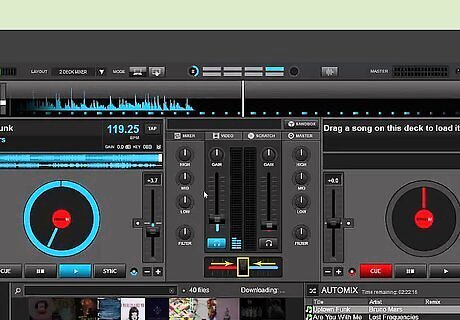
Open both audio channels by sliding the crossfader to the middle. Continue playing the first song until you get close to the end of it, then begin setting up your equipment for the new song. When the crossfader knob is in the middle of its track, it opens up both the left and right audio channels equally. You will be able to hear the second song as soon as you hit the play button. Another option is to ignore the crossfader and adjust both audio channels manually. Look for channel upfader knobs on the sides of the board. Operate the knob for the song you aren’t currently playing. Pull it up to open the audio channel.
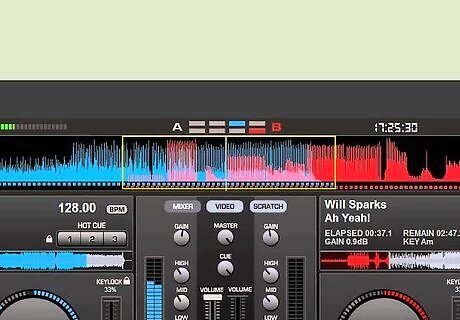
Start the new song on a beat near the end of the old song. Wait for a significant section at the end of the first song, such as during an instrumental chorus, to play the second song. Match the songs beat for beat so they don’t clash. Keep playing them side by side as the first song heads towards its conclusion. Listen to both songs through your headphones. When songs are played out loud, such as at a packed club, you hear a delay. The sound you hear in your headphones is more accurate, ensuring you line up the beats correctly. Try to find parts of both songs that are relatively empty, so there's space for both songs to play at the same time.
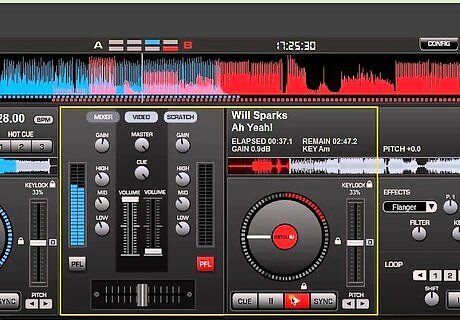
Adjust the volume and equalization controls to play the new song. Operate the volume control first, bringing the second song up to an audible level matching the first one. Then, use the equalization (EQ) controls to make fine adjustments to the audio. EQ enables you to change different frequencies, such as changing the level of bass or treble in a song. Watch the channel audio meter on your screen. Make sure it stays “in the yellow” for the most part, or in the middle of the color-coded meter. When the audio gets too high and goes “into the red,” the audio distorts. If you don’t have channel audio meters, watch the master volume meter. Spend a lot of time with the EQ controls at home while practicing your mixes. While you have plenty of time to adjust the second audio track, you still need to be careful with them in a live setting so they don’t disrupt the audio quality.
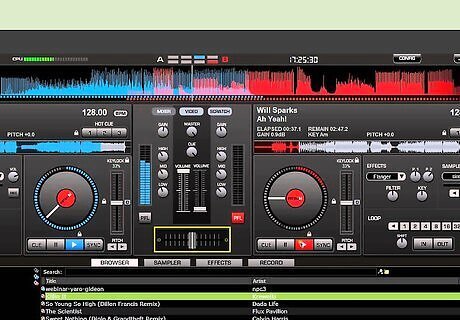
Blend the tracks together with fader controls. Begin nudging the crossfader bar towards the side responsible for the new track. If you’re using manual channel controls, move both knobs to about 75%. Listen to the music to make sure the sound level stays consistent. Use the master volume meter to monitor the overall sound level of the mix. If the volume dips too low, you turned down the audio too quickly.
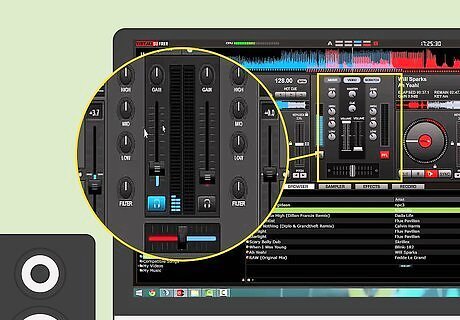
Fade out the old track while maintaining the new track’s overall volume. Take off your headphones if you’re wearing any and keep an eye on the master volume indicator. Listen to the beat of the music. Slowly raise the audio level for the new song. At the same time, decrease the audio level for the old song to complete the transition. The perfect transition is seamless. The beat never stops and listeners keep dancing. If you are able to hear the fading audio or abrupt song changes, you didn’t time your transition well enough. Practice with the songs to improve it.
Creating Better Mixes
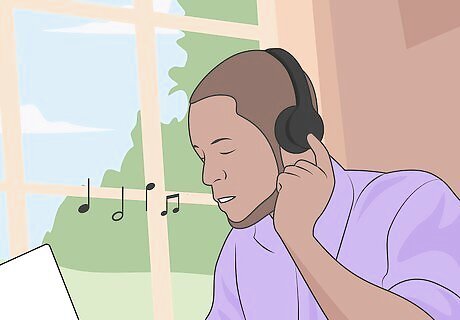
Use lyrics as an opportunity to transition during vocal sections. Lyrical phrases are like landmarks in songs. They often serve as a great tool to help you keep track of the song. Memorize the lyrics at the beginning and end of each song, counting the beats in these sections. Then, activate the second song to transition away from the first song. Transitioning between instrumental sections is much easier. For lyrical sections, you need to find a natural transition spot, like at the end of a chorus. Load up the new song on the second audio channel, preparing it in advance for the transition.

Remove the bass from fading songs to smooth out transitions. Booming bass sounds are a problem when songs play at the same time. The sound volume becomes overwhelming, making the audio sound terrible. You normally can’t combine them by playing them together, so use the EQ controls on your mixer to cut the bass while fading out the song you need to stop. A standard DJ controller has 3 EQ knobs controlling low, medium, and high frequencies on each knob. Pull the low frequency knob down to fade the bass out.
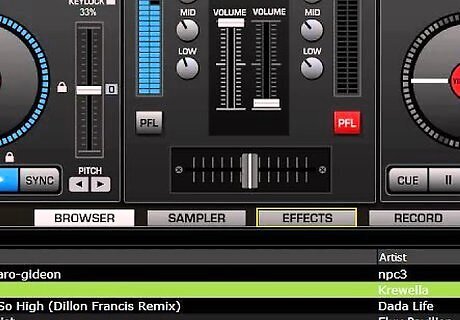
Add effects to transitions to give them personality and variety. Transitions throughout a long playlist tend to get monotonous, so DJs add special effects. DJ mixing controllers have buttons for effects like reverb, echo, and filters. Combine the effects with fading controls to keep audiences on their toes. Reverb causes voices to sound louder and richer. It also may cause music to sound industrial, which often works well on techno and house tracks. Use echo to emphasize a beat. While the beat echoes, fade the song out and come back strong with the beat from the new song. It’s a good way to cover up imperfect transitions, too. Effects like filters give music a different tone. Filters are basically EQ controls, which you use to separate frequencies in a track. A filter may isolate high vocals, for instance, and make them more intense.

Make your own remixes for unique songs and transitions. Remixes involve altering existing songs, such as by editing in sounds, looping segments, or combining different songs. You need an audio editing program like Audacity or Ableton Live. Once you make the tracks, add them to your mixing queue and transition between them like you normally would. Remixes give you an opportunity to customize songs. For example, mash together smaller segments of different songs, then perform spectacular transitions between them live to keep audiences on their toes. Use a remix live like any normal song. Try supplementing a remix with different effects and volume modulations from your mixing controls.
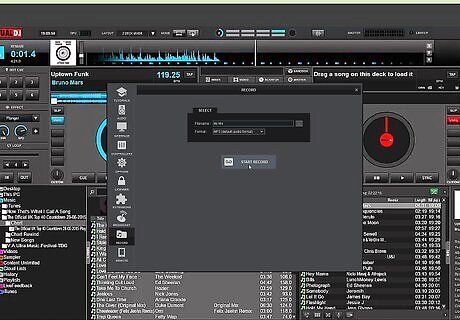
Record mixes and post them online to increase your following. While you practice going through an entire set list of songs at home, use your audio editing program to record yourself. Then, upload your unique mix to a site like Mixcloud or Soundcloud. You get a chance to spread your work without having to go out to the nearest club. Uploading websites are a great way to hone your mixing skills. Read feedback from your listeners to see where you need to improve.




















Comments
0 comment